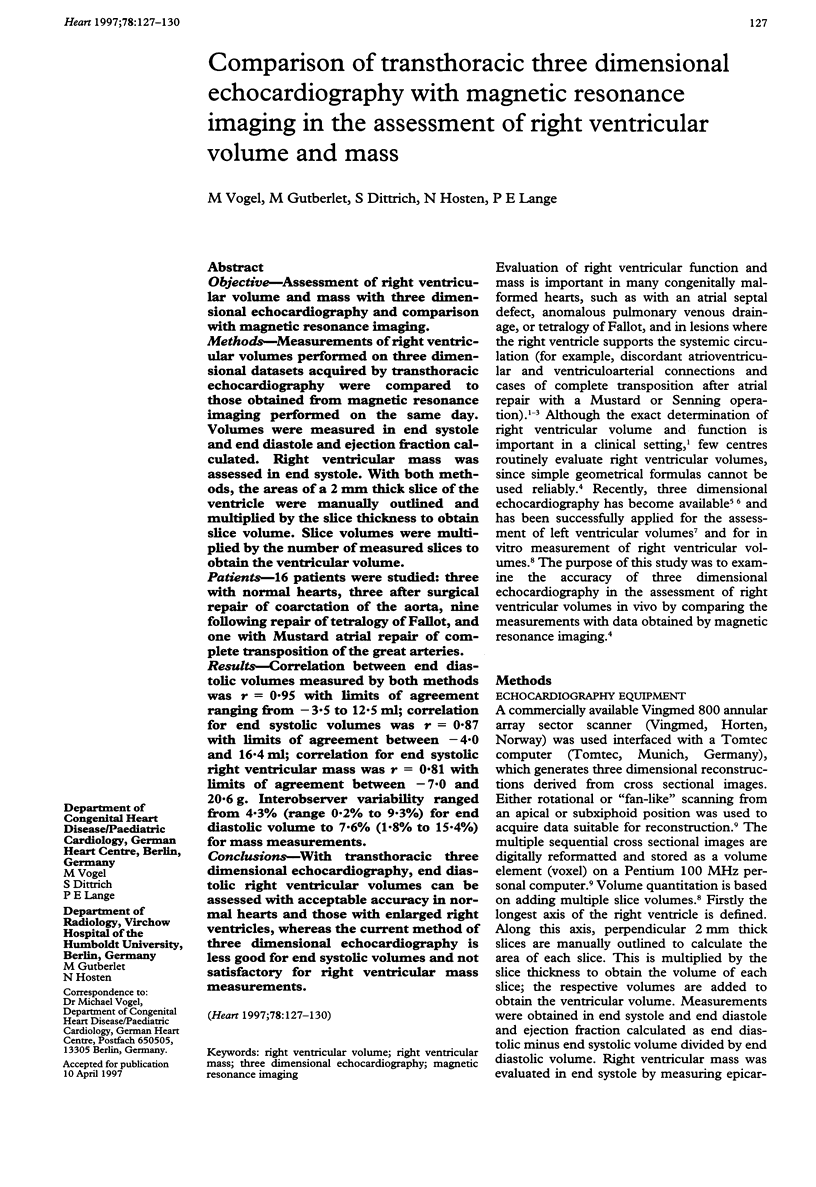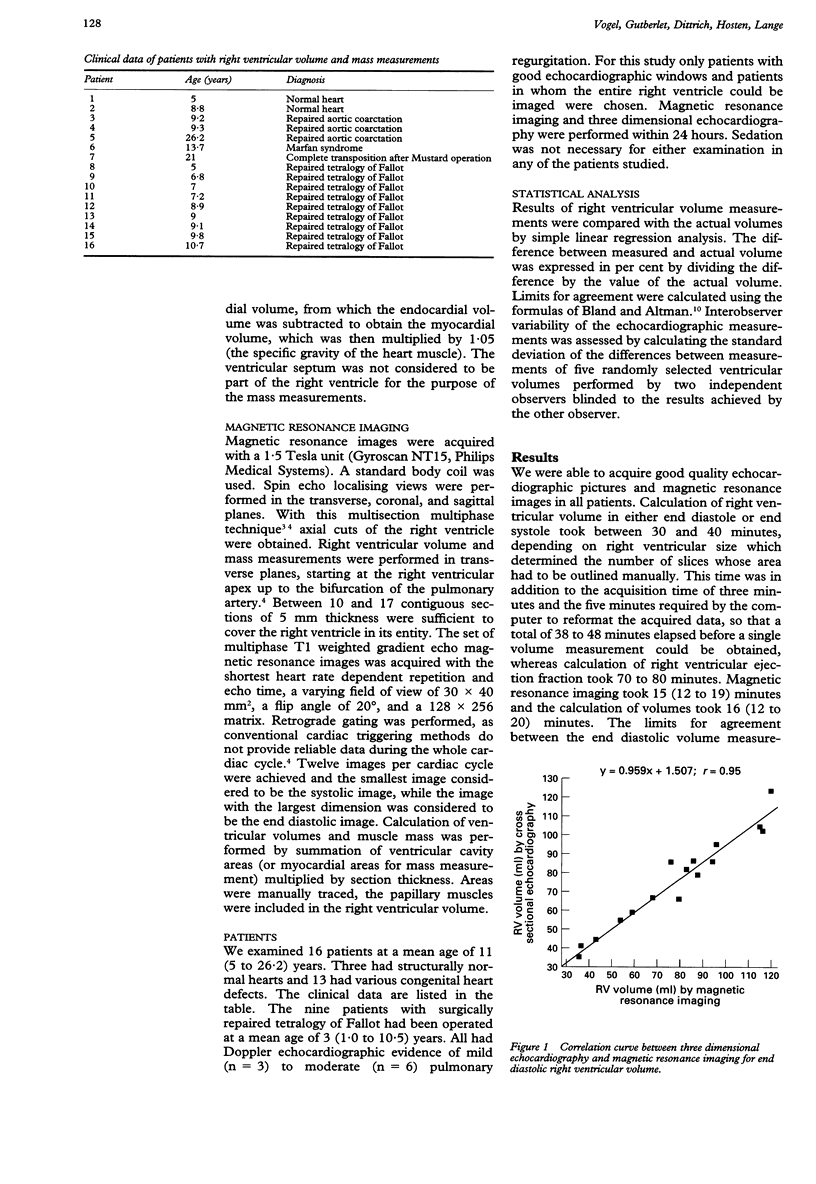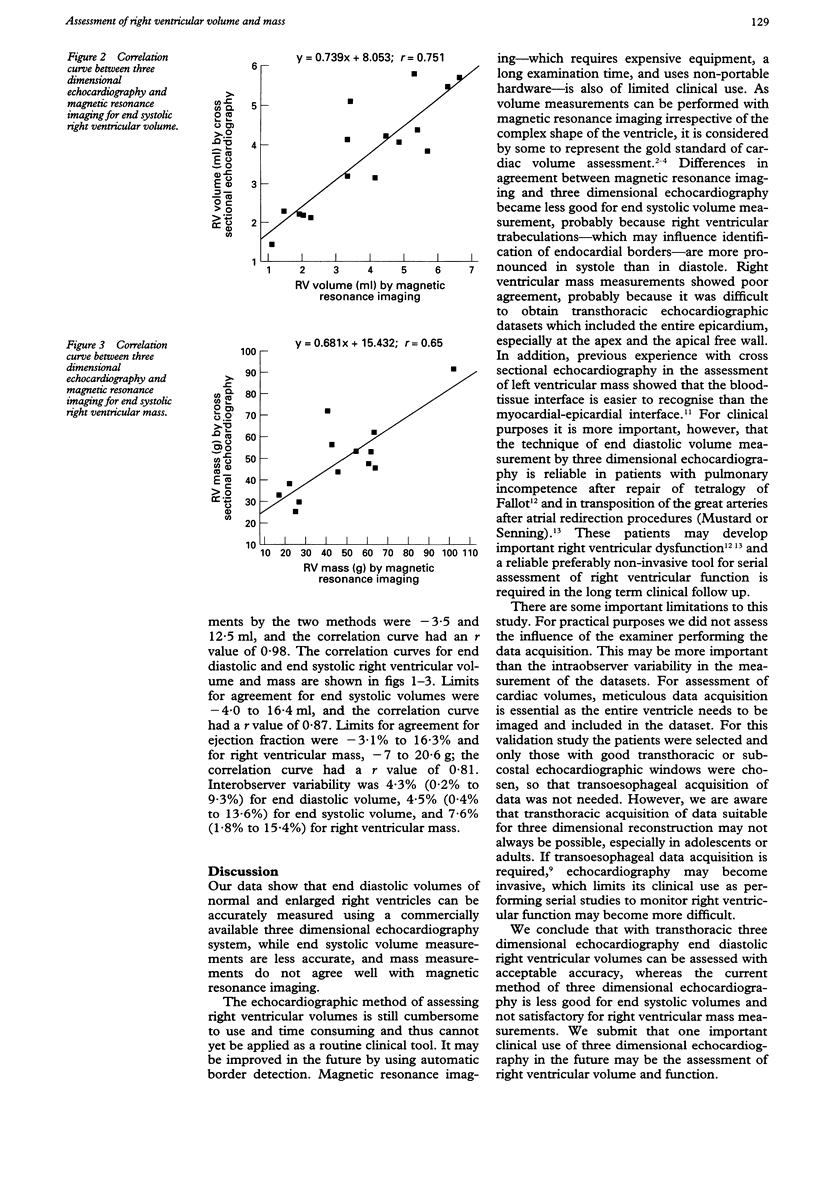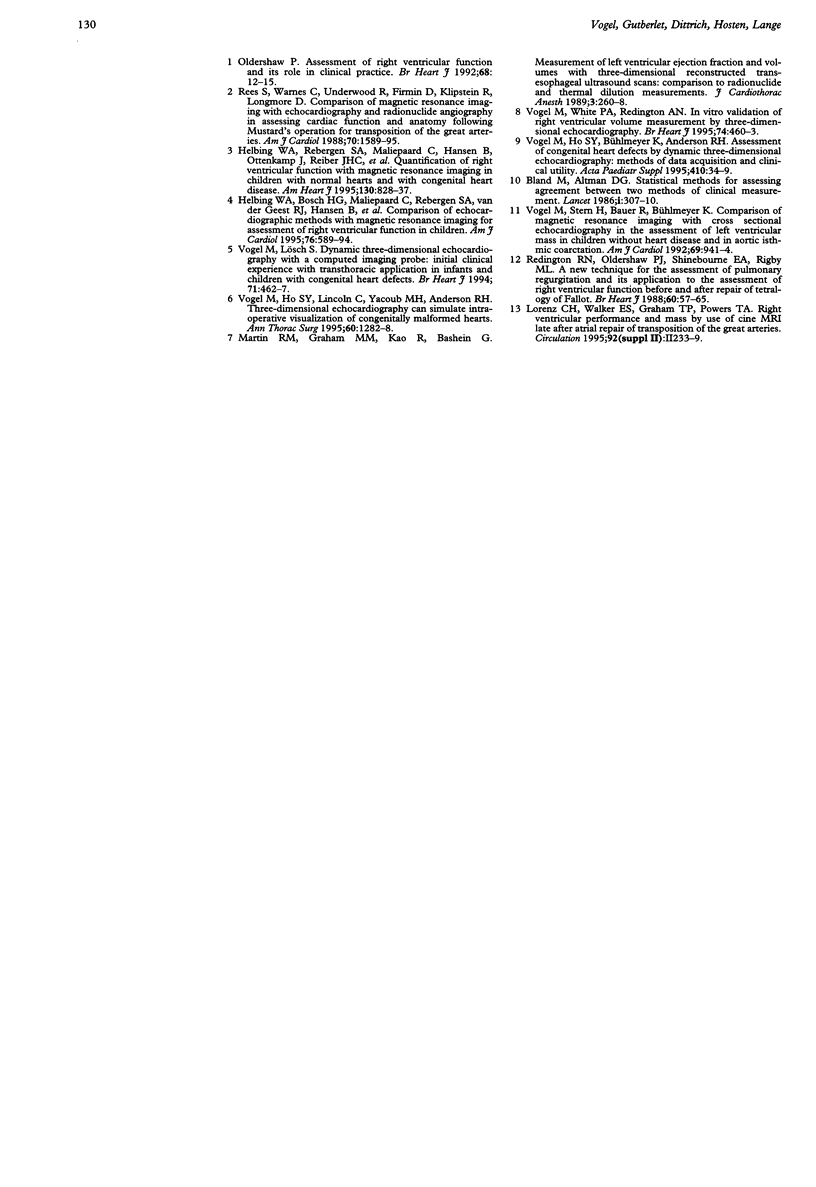Abstract
OBJECTIVE: Assessment of right ventricular volume and mass with three dimensional echocardiography and comparison with magnetic resonance imaging. METHODS: Measurements of right ventricular volumes performed on three dimensional datasets acquired by transthoracic echocardiography were compared to those obtained from magnetic resonance imaging performed on the same day. Volumes were measured in end systole and end diastole and ejection fraction calculated. Right ventricular mass was assessed in end systole. With both methods, the areas of a 2 mm thick slice of the ventricle were manually outlined and multiplied by the slice thickness to obtain slice volume. Slice volumes were multiplied by the number of measured slices to obtain the ventricular volume. PATIENTS: 16 patients were studied: three with normal hearts, three after surgical repair of coarctation of the aorta, nine following repair of tetralogy of Fallot, and one with Mustard atrial repair of complete transposition of the great arteries. RESULTS: Correlation between end diastolic volumes measured by both methods was r = 0.95 with limits of agreement ranging from -3.5 to 12.5 ml; correlation for end systolic volumes was r = 0.87 with limits of agreement between -4.0 and 16.4 ml; correlation for end systolic right ventricular mass was r = 0.81 with limits of agreement between -7.0 and 20.6 g. Interobserver variability ranged from 4.3% (range 0.2% to 9.3%) for end diastolic volume to 7.6% (1.8% to 15.4%) for mass measurements. CONCLUSIONS: With transthoracic three dimensional echocardiography, end diastolic right ventricular volumes can be assessed with acceptable accuracy in normal hearts and those with enlarged right ventricles, whereas the current method of three dimensional echocardiography is less good for end systolic volumes and not satisfactory for right ventricular mass measurements.
Full text
PDF



Selected References
These references are in PubMed. This may not be the complete list of references from this article.
- Bland J. M., Altman D. G. Statistical methods for assessing agreement between two methods of clinical measurement. Lancet. 1986 Feb 8;1(8476):307–310. [PubMed] [Google Scholar]
- Helbing W. A., Bosch H. G., Maliepaard C., Rebergen S. A., van der Geest R. J., Hansen B., Ottenkamp J., Reiber J. H., de Roos A. Comparison of echocardiographic methods with magnetic resonance imaging for assessment of right ventricular function in children. Am J Cardiol. 1995 Sep 15;76(8):589–594. doi: 10.1016/s0002-9149(99)80161-1. [DOI] [PubMed] [Google Scholar]
- Helbing W. A., Rebergen S. A., Maliepaard C., Hansen B., Ottenkamp J., Reiber J. H., de Roos A. Quantification of right ventricular function with magnetic resonance imaging in children with normal hearts and with congenital heart disease. Am Heart J. 1995 Oct;130(4):828–837. doi: 10.1016/0002-8703(95)90084-5. [DOI] [PubMed] [Google Scholar]
- Martin R. W., Graham M. M., Kao R., Bashein G. Measurement of left ventricular ejection fraction and volumes with three-dimensional reconstructed transesophageal ultrasound scans: comparison to radionuclide and thermal dilution measurements. J Cardiothorac Anesth. 1989 Jun;3(3):260–268. doi: 10.1016/0888-6296(89)90105-1. [DOI] [PubMed] [Google Scholar]
- Oldershaw P. Assessment of right ventricular function and its role in clinical practice. Br Heart J. 1992 Jul;68(1):12–15. doi: 10.1136/hrt.68.7.12. [DOI] [PMC free article] [PubMed] [Google Scholar]
- Redington A. N., Oldershaw P. J., Shinebourne E. A., Rigby M. L. A new technique for the assessment of pulmonary regurgitation and its application to the assessment of right ventricular function before and after repair of tetralogy of Fallot. Br Heart J. 1988 Jul;60(1):57–65. doi: 10.1136/hrt.60.1.57. [DOI] [PMC free article] [PubMed] [Google Scholar]
- Vogel M., Ho S. Y., Bühlmeyer K., Anderson R. H. Assessment of congenital heart defects by dynamic three-dimensional echocardiography: methods of data acquisition and clinical potential. Acta Paediatr Suppl. 1995 Aug;410:34–39. doi: 10.1111/j.1651-2227.1995.tb13842.x. [DOI] [PubMed] [Google Scholar]
- Vogel M., Ho S. Y., Lincoln C., Yacoub M. H., Anderson R. H. Three-dimensional echocardiography can simulate intraoperative visualization of congenitally malformed hearts. Ann Thorac Surg. 1995 Nov;60(5):1282–1288. doi: 10.1016/0003-4975(95)00615-R. [DOI] [PubMed] [Google Scholar]
- Vogel M., Lösch S. Dynamic three-dimensional echocardiography with a computed tomography imaging probe: initial clinical experience with transthoracic application in infants and children with congenital heart defects. Br Heart J. 1994 May;71(5):462–467. doi: 10.1136/hrt.71.5.462. [DOI] [PMC free article] [PubMed] [Google Scholar]
- Vogel M., Stern H., Bauer R., Bühlmeyer K. Comparison of magnetic resonance imaging with cross-sectional echocardiography in the assessment of left ventricular mass in children without heart disease and in aortic isthmic coarctation. Am J Cardiol. 1992 Apr 1;69(9):941–944. doi: 10.1016/0002-9149(92)90797-3. [DOI] [PubMed] [Google Scholar]
- Vogel M., White P. A., Redington A. N. In vitro validation of right ventricular volume measurement by three dimensional echocardiography. Br Heart J. 1995 Oct;74(4):460–463. doi: 10.1136/hrt.74.4.460. [DOI] [PMC free article] [PubMed] [Google Scholar]


